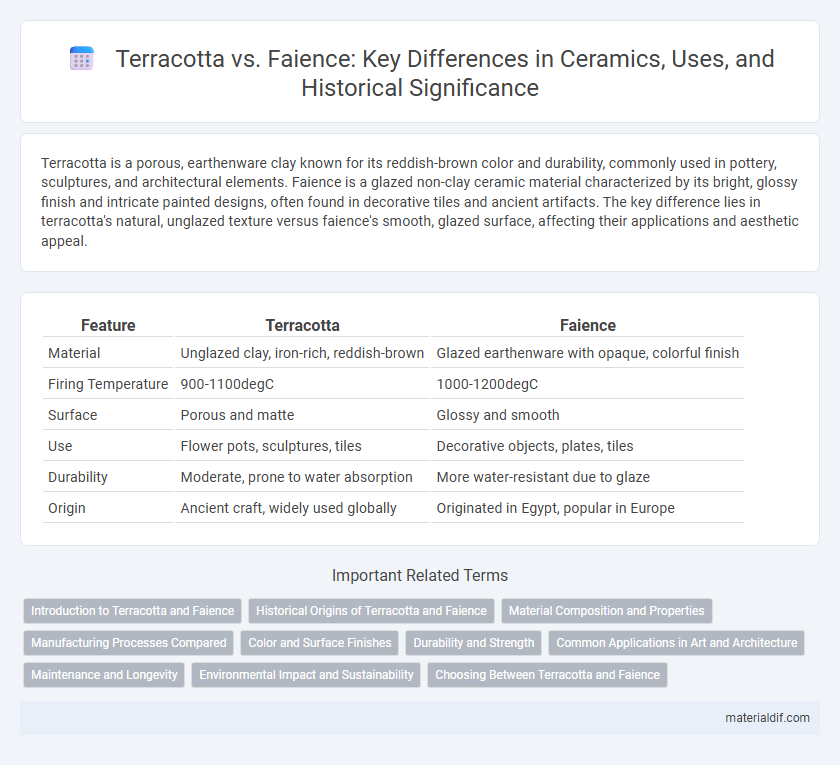Terracotta is a porous, earthenware clay known for its reddish-brown color and durability, commonly used in pottery, sculptures, and architectural elements. Faience is a glazed non-clay ceramic material characterized by its bright, glossy finish and intricate painted designs, often found in decorative tiles and ancient artifacts. The key difference lies in terracotta's natural, unglazed texture versus faience's smooth, glazed surface, affecting their applications and aesthetic appeal.
Table of Comparison
| Feature | Terracotta | Faience |
|---|---|---|
| Material | Unglazed clay, iron-rich, reddish-brown | Glazed earthenware with opaque, colorful finish |
| Firing Temperature | 900-1100degC | 1000-1200degC |
| Surface | Porous and matte | Glossy and smooth |
| Use | Flower pots, sculptures, tiles | Decorative objects, plates, tiles |
| Durability | Moderate, prone to water absorption | More water-resistant due to glaze |
| Origin | Ancient craft, widely used globally | Originated in Egypt, popular in Europe |
Introduction to Terracotta and Faience
Terracotta, an unglazed, porous ceramic made from natural clay, is known for its rich earthy tones and durability, commonly used in pottery, sculptures, and building materials. Faience, a glazed non-clay ceramic, features a bright, glossy surface created by applying a vitreous coating to a silica-based body, often decorated with intricate patterns and vibrant colors. Both materials have historical significance, with terracotta dating back to ancient civilizations for practical uses, while faience gained prominence for its decorative and symbolic applications.
Historical Origins of Terracotta and Faience
Terracotta, dating back to ancient Mesopotamia around 4000 BCE, was primarily used for pottery, sculpture, and architectural decorations due to its porous clay composition. Faience originated in ancient Egypt around 3000 BCE as a glazed non-clay ceramic material, valued for its bright blue-green surface achieved through quartz-based frit and alkali glazing techniques. These distinct historical origins highlight terracotta's role in functional and decorative earthware, while faience became prominent for its vibrant sheen and symbolic significance in funerary and religious artifacts.
Material Composition and Properties
Terracotta is a porous, earthenware ceramic made primarily from natural clay fired at lower temperatures, resulting in a dense but slightly brittle material with good thermal insulation properties. Faience, on the other hand, is composed of finely ground quartz or sand mixed with alkaline flux and a glaze, fired at high temperatures to produce a smooth, glassy surface that is non-porous and highly decorative. The difference in material composition leads to terracotta's suitability for structural uses and pottery while faience excels in ornamental objects due to its vibrant colors and glossy finish.
Manufacturing Processes Compared
Terracotta manufacturing involves shaping natural clay, then drying and firing it at relatively low temperatures between 900degC and 1050degC, resulting in a porous and often reddish-brown ceramic body. In contrast, faience production includes coating a porous ceramic core, usually made from a mixture of quartz and clay, with a vitreous glaze that fuses during firing at higher temperatures around 1000degC to 1100degC, producing a glossy, non-porous surface. The key difference lies in terracotta's unglazed, earthy texture formed purely by clay composition and firing, while faience requires an additional glazing step that enhances durability and aesthetic appeal.
Color and Surface Finishes
Terracotta features warm, earthy tones ranging from red, orange, to brown, characterized by a porous, matte surface that absorbs color variably during firing. Faience exhibits a vibrant and glossy finish, typically with bright blues, greens, and turquoise hues achieved through a tin-glazing technique that creates an opaque, lustrous surface. The distinct color vibrancy and surface reflectivity of faience contrast with terracotta's rustic, natural finish, influencing their application in decorative arts and architecture.
Durability and Strength
Terracotta exhibits higher durability and strength due to its dense, fired clay composition, making it suitable for structural and outdoor applications. Faience, often glazed and more porous, offers lower mechanical strength but excels in decorative uses and indoor settings. The inherent toughness of terracotta results from its reduced porosity and robust firing process compared to the more delicate faience.
Common Applications in Art and Architecture
Terracotta is widely used in architectural elements such as roof tiles, sculptures, and ornamental facades due to its durability and earthy aesthetic. Faience, characterized by its glazed surface, is commonly employed in decorative art pieces, intricate mosaics, and ceremonial objects, providing vibrant color and intricate detail. Both materials have been integral to cultural heritage, with terracotta often featured in functional architectural forms and faience prized for ornamental and symbolic purposes.
Maintenance and Longevity
Terracotta requires regular sealing to prevent moisture absorption and surface stains, which can degrade its durability over time, especially in high-traffic or outdoor settings. Faience, being a glazed ceramic with a vitreous surface, offers superior resistance to water, stains, and scratches, resulting in lower maintenance and longer-lasting appearance. While terracotta may develop a rustic patina that can enhance its aesthetic appeal, faience tiles maintain their vibrant glazes with minimal upkeep, making them preferable for long-term, easy-care applications.
Environmental Impact and Sustainability
Terracotta demonstrates a lower environmental impact due to its natural clay composition and energy-efficient firing process, resulting in reduced carbon emissions compared to faience, which incorporates glazes and requires higher kiln temperatures. The sustainability of terracotta is further enhanced by its biodegradability and minimal chemical additives, whereas faience's synthetic glazes may introduce pollutants and complicate recycling efforts. Choosing terracotta supports eco-friendly ceramic production, minimizing resource consumption and promoting circular material use.
Choosing Between Terracotta and Faience
Choosing between terracotta and faience depends on the desired finish and durability; terracotta offers a porous, earthy texture ideal for rustic pottery and gardenware, while faience provides a glazed, colorful surface suited for decorative tiles and fine ceramics. Terracotta's natural reddish-brown color and robustness make it cost-effective for functional uses, whereas faience, characterized by its tin-glazed, glossy finish, excels in ornamental applications requiring intricate designs and vibrant hues. Understanding the material properties and intended use helps determine whether terracotta's traditional appeal or faience's decorative elegance better fits the project needs.
Terracotta vs Faience Infographic

 materialdif.com
materialdif.com